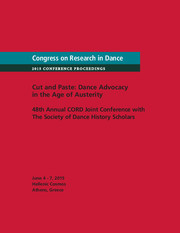No CrossRef data available.
Article contents
Migratory Moves and Mobilizing Tactics in British Contemporary Dance
Published online by Cambridge University Press: 04 January 2013
Abstract
This paper concerns the migration of American modern dance to Britain throughout the 1960s and 1970s when Martha Graham's technique and repertory were introduced to British dancers and audiences. The author addresses these issues from a historical and phenomenological point of view using her memories and reflections, the data from the research she has conducted into this milestone in British dance history, and the theories of Pierre Bourdieu.
- Type
- Research Article
- Information
- Copyright
- Copyright © The Author(s) 2007
References
Works Cited
Adshead, Janet, and Mansfield, Richard. 1985. London Contemporary Dance Theatre 1967–1975. Surrey: NRCD.Google Scholar
Anglin, Werdon. 1985. “The Royal Ballet and Sadler's Wells.” In 20th Century Dance in Britain: A History of Five Dance Companies, edited by White, Joan, 53–86. London: Dance Books.Google Scholar
Bannerman, Henrietta, and Nicholas, Larraine. 2001. “The Graham Explosion in Britain: Evolution or Revolution?” In European Association of Dance Historians—Dance History: The Teaching and Learning of Dance History Conference Proceedings, 145–55. London: EADH.Google Scholar
Bourdieu, Pierre. 1977. Outline of a Theory of Practice. Translated by Nice, Richard. Cambridge: Cambridge University Press.CrossRefGoogle Scholar
Bourdieu, Pierre. 1993. The Field of Cultural Production. Edited and introduced by Johnson, Randal. Cambridge: Polity Press.Google Scholar
Bourdieu, Pierre, and Wacquant, Loïc. 1992. An Invitation to Reflexive Sociology. Cambridge: Polity Press.Google Scholar
Clarke, Mary, Crisp, Clement, and Crickmay, Anthony. 1989. London Contemporary Dance Theatre: The First 21 Years. London: Dance Books.Google Scholar
Mann, Jenny. 1985. “Ballet Rambert.” In 20th Century Dance in Britain: A History of Five Dance Companies, edited by White, Joan, 15–52. London: Dance Books.Google Scholar
Mansfield, Richard. 1985. “London Contemporary Dance Theatre.” In 20th Century Dance in Britain: A History of Five Dance Companies, edited by White, Joan, 111–42. London: Dance Books.Google Scholar
“Martha Graham Dance Company—Bare-Foot Drama.” 1954. The Times [London], March 2.Google Scholar
Morris, Gay. 2001. “Bourdieu, the Body, and Graham's Post-War Dance.” Dance Research 19: 52–82.CrossRefGoogle Scholar
Nicholas, Larraine. 2007. Dancing in Utopia: Dartington Hall and Its Dancers. London: Dance Books.Google Scholar
Percival, John. 1983. Theatre in My Blood: A Biography of John Cranko. London: Herbert Press.Google Scholar
Preston-Dunlop, Valerie, and Espana, Luis. 2005. The American Invasion, 1962–1972 [DVD]. London: Dance Books.Google Scholar
Siegel, Marcia. 1993. Days on Earth: The Dance of Doris Humphrey. Durham, NC: Duke University Press.Google Scholar
Stöckemann, Patricia. 2001. Etwas ganz Neues muss nun entstehen: Kurt Jooss und das Tanztheater. München: Kieser.Google Scholar


